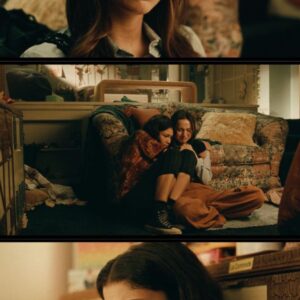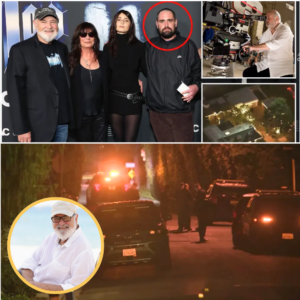In the churning undercurrents of contemporary television, where Scandinavian chill and American grit have long dominated the crime genre, a new force is rising from the rugged Welsh coast: Under Salt Marsh. This six-part Sky Original, helmed by the visionary Claire Oakley, stars Yellowstone‘s Kelly Reilly in a role that’s already being hailed as her most incendiary since Beth Dutton’s bourbon-fueled rampages. Premiering in early 2026 on Sky and streaming platforms worldwide, the series plunges viewers into the fictional enclave of Morfa Halen—a storm-battered Welsh town squeezed between jagged mountains and an insatiable sea that devours land and secrets alike. Here, Reilly’s Jackie Ellis isn’t just a detective; she’s a woman adrift, her life shipwrecked by a cold case that stripped her of badge, family, and sanity. Reuniting with her ex-partner, the brooding Eric Bull (Rafe Spall), Jackie uncovers a labyrinth of lies that threatens to submerge the entire community. If HBO’s Mare of Easttown twisted the knife in small-town Pennsylvania, Under Salt Marsh drives it deeper into the Celtic soul—darker, wetter, and more relentlessly human. With first-look images dropping in September 2025 that left fans gasping, this isn’t just a thriller; it’s a tidal wave crashing over the genre, proving Reilly’s post-Yellowstone fire is unquenchable.
The series opens on the brink of cataclysm: a once-in-a-generation tempest brews offshore, its gales howling like the ghosts of the drowned. Morfa Halen, with its salt-crusted cottages clinging to cliffs and fishing boats bobbing like forgotten prayers, feels alive—pulsing with the rhythm of the waves that both sustain and sabotage its people. Jackie Ellis, once a rising star in the local constabulary, has traded her warrant card for a chalkboard, teaching primary school to eight-year-olds who stare at her with the wide-eyed trust she no longer has in herself. That fragile peace shatters when she stumbles upon the body of Cefin, one of her brightest pupils, his small frame twisted among the salt marsh reeds, eyes vacant toward the roiling sky. Drowned, the coroner rules at first glance—but Jackie knows better. The boy’s pallor, the faint bruises blooming like ink under his skin, scream foul play. And as the sirens wail and the community huddles in the pub nursing pints against the chill, the discovery rips open a three-year-old scar: the vanishing of Jackie’s niece, Nessa, a spirited girl of ten who slipped into the marsh one foggy dawn and never resurfaced.
That cold case wasn’t just a professional gut-punch; it was personal Armageddon. Nessa was Jackie’s sister’s child, her own flesh in miniature, and the botched investigation—riddled with overlooked leads and departmental finger-pointing—cost Jackie everything. Her marriage crumbled under the weight of blame, her husband fleeing to the mainland with whispers of negligence. Her sister, hollowed by grief, severed ties with a finality sharper than any gale. Colleagues turned their backs, branding her obsessive, unreliable—a liability in a force already stretched thin by budget cuts and coastal isolation. Jackie fled the badge, burying her instincts under lesson plans and seaside solitude, convincing herself the marsh had claimed another innocent. But Cefin’s death drags her under like quicksand. Convinced the boys’ fates are entwined—perhaps a predator stalking the shallows, or a web of local malice—she can’t stay silent. When Eric Bull arrives, summoned from Cardiff to helm the probe, the past floods back like high tide.
Eric Bull, played with gravel-voiced intensity by Spall, is the ex she both loathes and needs—the partner whose loyalty frayed when the Nessa case turned toxic. Tall, rumpled, with eyes like weathered slate, Eric carries his own ghosts: a failed prior stint in Morfa Halen that ended in demotion and divorce, his once-sharp instincts dulled by desk work and regret. Their reunion in the incident room crackles with unspoken history—a charged glance over crime scene photos, a hand lingering too long on a shared coffee. “You always did chase shadows,” he mutters, but there’s no venom; only the weary recognition of two souls warped by the same storm. As the investigation deepens, they pore over Cefin’s last hours: a playground scuffle with older lads, whispers of a “marsh man” in local lore, and a cryptic drawing from the boy depicting stick figures vanishing into reeds. Nessa’s file yields fresh clues too—a overlooked witness statement from a shell-shocked fisherman, fibers on her jacket matching Cefin’s schoolbag. But Morfa Halen isn’t a quaint village; it’s a pressure cooker of resentments. The mining town’s economy has eroded like its cliffs, leaving fishermen turned poachers, families fractured by addiction, and elders guarding grudges older than the Welsh hills.
Episode one, “Tide’s Turn,” sets the hook with merciless efficiency: Jackie’s dawn walk to school, the marsh mist coiling like cigarette smoke, the gut-wrenching discovery that leaves her retching into the surf. Flashbacks intercut the horror—Nessa’s laughter echoing from three years prior, Jackie’s frantic searches with torchlight cutting the fog—building a portrait of a woman forged in loss. By the midpoint, Eric’s arrival forces a tentative truce, their first joint interview with Cefin’s shell-shocked mother (a heartbreaking turn by Welsh actress Kimberley Nixon) peeling back layers of communal silence. The episode closes on a cliffhanger: a submerged child’s shoe surfacing at low tide, etched with Nessa’s initials. Viewers won’t exhale until the credits roll, and even then, the unease lingers like brine on skin.
As the series surges forward, the storm literalizes the emotional deluge. Episode two, “Reeds and Reckonings,” plunges Jackie and Eric into the town’s underbelly: interrogating a volatile ex-con (Brian Gleeson, channeling feral menace) with ties to both cases, sifting through Nessa’s archived drawings that eerily mirror Cefin’s. Secrets erupt like geysers—Jackie’s hidden affair with Eric during the original probe, a cover-up involving the local magistrate (Jonathan Pryce, his avuncular charm curdling into corruption). Pryce’s Ellis ap Hywel is a pillar of Morfa Halen, a retired judge whose family owns half the marshland, but his alibi frays under scrutiny, revealing a network of favors traded for silence. The episode’s pulse-pounder: a midnight stakeout in the salt flats, where Jackie and Eric witness a clandestine meet between hooded figures, the wind whipping their whispers into oblivion. Spall’s Eric shines here, his vulnerability cracking through the stoicism—a drunken confession in the patrol car about the night he walked away from Jackie, leaving her to drown in doubt alone.
The ensemble orbits this central duo like debris in a riptide, each adding ballast to the narrative’s swell. Naomi Yang brings quiet ferocity as Seren, Jackie’s estranged sister and Nessa’s mother, her grief a simmering rage that boils over in family confrontations laced with Welsh invective. Harry Lawtey, fresh from Industry‘s cutthroat boardrooms, plays young constable Rhys, Eric’s eager protégé whose idealism masks a personal stake—Cefin was his cousin, fueling a reckless pursuit that endangers the team. Dinita Gohil’s Dr. Mira Patel, the forensic pathologist with a no-nonsense scalpel wit, unearths anomalies in the autopsies: trace toxins suggesting deliberate poisoning masked as drowning. Mark Stanley’s grizzled fisherman Dai, a Nessa suspect with alibi-shredding tattoos, embodies the town’s blue-collar defiance, while Dino Fetscher’s enigmatic outsider, a storm-chasing journalist sniffing the story, injects paranoia— is he ally or agitator? Lizzie Annis and Rhodri Meilir round out the locals, their roles weaving in subplots of infidelity and inheritance that ripple outward, implicating nearly everyone by mid-season.
Oakley’s direction—moody, immersive, shot on location in Wales’ wild Pen Llyn peninsula—transforms the landscape into a character as treacherous as any villain. Cinematographer Suzie Davies captures the marsh’s duality: golden-hour glows masking treacherous bogs, bioluminescent plankton flickering like lost souls at night. The encroaching storm builds cinematically, from distant thunder rumbles to episode four’s visceral fury, where howling winds lash the set, forcing Jackie and Eric into a derelict lighthouse for a rain-soaked reckoning. Writers Jonathan Harbottle and Nikita Lalwani layer in psychological depth, drawing from Welsh folklore—the afanc water monsters, the spectral ladies of the lakes—to infuse the procedural with mythic resonance. Themes of erosion mirror the plot: how grief hollows families, how silence erodes justice, how a community can swallow its sins like the tide claims wrecks.
Production on Under Salt Marsh was a tempest in itself, commencing in late 2024 amid Wales’ relentless downpours. Filmed over five months in remote coastal hamlets like Abersoch and Pwllheli, the shoot battled gales that toppled rigs and flooded sets, mirroring the script’s chaos. Oakley, whose debut feature Make Up earned Sundance raves for its atmospheric dread, co-executive produces alongside Reilly, who championed the project post-Yellowstone‘s wrap. “Jackie’s wildness called to me—the untamed heart of a woman reclaiming her fury,” Oakley shared in a rare interview. Little Door Productions, backed by Sky Studios, poured authenticity into the brew: dialect coaches ensuring the lilting Welsh-English patois rang true, marine consultants advising on tidal forensics, and community liaisons from Creative Wales amplifying local hires. The score, a haunting blend of harp drones and crashing percussion by Emmy-nominee Isobel Waller-Bridge, underscores the isolation, its motifs swelling like waves to cue revelations.
Early buzz positions Under Salt Marsh as a genre disruptor, outpacing Mare of Easttown‘s rust-belt introspection with Celtic ferocity. Where Kate Winslet’s Mare Sheehan wrestled personal demons amid opioid haze, Reilly’s Jackie is primal—scarred but unbowed, her obsession a double-edged blade that cuts deeper with each episode. Critics previewing pilots at the Edinburgh TV Festival in August 2025 dubbed it “HBO’s Mare meets Broadchurch‘s brine,” praising Reilly’s “electrifying pivot from Dutton’s venom to Ellis’s vulnerability.” Spall, no stranger to brooding leads (The English‘s outlaw grit), matches her beat for beat, their chemistry a slow-burn inferno that ignites in episode three’s bottle episode: a lockdown in the storm-lashed school, where buried confessions force a fragile alliance.
Fan fervor crested with the September 24, 2025, first-look drop: stark black-and-white stills of Reilly knee-deep in marsh muck, Spall silhouetted against crashing surf, Pryce’s gaze heavy with unspoken sins. Social media surged—#UnderSaltMarsh trended UK-wide, with Yellowstone diehards posting “Beth who? Kelly’s serving haunted queen energy” alongside 100K likes. TikTok edits mash Reilly’s Dutton snarl with Jackie’s tear-streaked resolve, while Reddit theorizes twists: Is Nessa alive, hidden in the hills? Does Eric’s “failure” hide a darker complicity? The series arrives amid a Welsh noir renaissance—The Jetty, Vigil—but carves its niche with emotional rawness, a requiem for the overlooked that resonates in our fractured times.
By the finale, “Storm’s Reckoning,” the tempest breaks fully: evidence scatters like chaff, alliances shatter, and Jackie faces the abyss—truth or tidal oblivion? The resolution, laced with bittersweet ambiguity, leaves scars that linger, much like the marsh’s receding waters revealing bones long buried. Under Salt Marsh isn’t mere escapism; it’s an immersion in resilience’s razor edge, where obsession redeems or ruins. With Reilly ablaze—her haunted eyes piercing the screen like lighthouse beams—this thriller doesn’t just top Mare; it redefines the depths. As Morfa Halen’s waves crash eternal, one thing’s certain: Kelly Reilly’s fire illuminates the dark, and we’re all a little more submerged for it.

